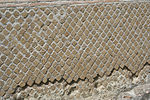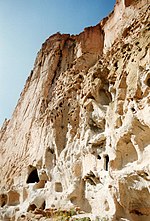 | Roman concrete (redirect from Opus caementicium) Roman concrete, also called opus caementicium, was used in construction in ancient Rome. Like its modern equivalent, Roman concrete was based on a hydraulic-setting... 19 KB (2,032 words) - 23:24, 18 February 2024 |
 | Reticulate work developed in response to the advent of opus caementicium and its predecessor, opus incertum.: 136–45 This was to accommodate both the new... 20 KB (2,279 words) - 08:21, 27 March 2024 |
 | placed uncut stones or fist-sized tuff blocks inserted in a core of opus caementicium. Initially it consisted of more careful placement of the caementa... 2 KB (182 words) - 21:48, 31 December 2023 |
 | Opus signinum ('cocciopesto' in modern Italian) is a building material used in ancient Rome. It is a form of Roman concrete (opus caementicium), the main... 5 KB (664 words) - 11:22, 20 February 2024 |
of opus caementicium. Opus latericium Ancient Roman form of construction in which coarse-laid brickwork is used to face a core of opus caementicium. Opus... 41 KB (5,068 words) - 06:54, 6 March 2024 |
Roman masonry in diamond-shaped bricks of tuff, covering a core of opus caementicium G.R.H. Wright (23 November 2009). Ancient Building Technology, Volume... 3 KB (414 words) - 10:20, 8 April 2024 |
 | from the original on February 14, 2014. Retrieved 31 December 2014. Opus caementicium roman walls Wikimedia Commons has media related to Opus spicatum.... 4 KB (404 words) - 09:42, 19 March 2024 |
 | I-beam – steel lintels and beams Marriage stone – decorative lintel Opus caementicium Structural design Timber framing – post and beam systems Stonehenge... 7 KB (748 words) - 21:29, 27 March 2024 |
 | opus quadratum – Roman masonry using parallel courses of squared stone of the same height Pietra dura Roman concrete, also known as opus caementicium –... 8 KB (997 words) - 02:36, 9 November 2023 |
 | Romans made extensive use of rubble masonry, calling it opus caementicium, because caementicium was the name given to the filling between the two revetments... 3 KB (419 words) - 02:43, 3 July 2023 |
 | Maria Laura Santarelli. 2006. "Mechanical characteristics of Roman 'opus caementicium'". Fracture and Failure of Natural Building Stones. Applications in... 41 KB (4,757 words) - 23:04, 22 April 2024 |
villas which included the fishponds, private harbours and docks in opus caementicium. Nevertheless a rich resource of inscriptions documenting the population... 9 KB (1,190 words) - 00:36, 1 April 2024 |
 | × 162 ft) and 7 m (23 ft) in height. The building was constructed in opus caementicium and originally covered with slabs of tuff which were later removed... 13 KB (1,573 words) - 03:03, 10 March 2024 |
 | tecta, lower portico and upper portico respectively and were built in opus caementicium. The special feature is the sophisticated structure of the vaults... 23 KB (3,208 words) - 17:16, 21 March 2024 |
















